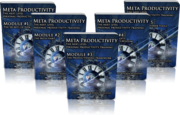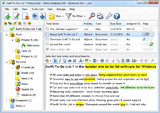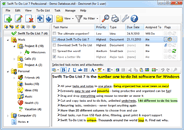The basic idea of Getting Things Done, or GTD, is not simply accomplishing the tasks you need to accomplish but doing so in an efficient manner. Obviously, the end product – a finished to-do list with all of your jobs well done – is essential to success, but the GTD methodology focuses more on the process than its product. As such, GTD is geared toward creating a system to manage your work that is self-sufficient and reduces your stress level rather than increase it. Creating such a to-do list is relatively easy when you’re using a good personal organizer.
Unfortunately, modern life presents with a dizzying array of commitments, both work-related and independent of work. Thus, a major component of GTD stressed by author David Allen is that of commitment management. Commitment management offers a way to clear your mind prior to taking on tasks so that you can focus all of your energy on the task at hand.
The first component: Identifying commitments
The first part of commitment management is essentially a brainstorming session in which you identify all of the commitments you have and put them on paper. These commitments can be new assignments or ongoing projects – “anything you consider unfinished in any way,” says Allen – and can be work for your boss or chores you need to do at home. Because these thoughts are cluttering your mind, merely thinking about them won’t help you focus on anything in particular. Instead, you need to put them into what Allen calls a “collection bucket,” and what we like to call a Swift To-Do List task list.
The key features of a “collection bucket” are that you can easily see all of the individual tasks and that you can revisit them whenever you need to. A Swift To-Do List 7 task list satisfies both of these, as the list is just a mouse click away. Using Swift To-Do List 7 actually improves upon the traditional “bucket” design thanks to the to-do list tree. You can create different lists and sub-lists to keep commitments organized. This is particularly helpful if you have multiple projects going on.
Virtually everyone has multiple projects – at minimum, you have your work and personal life. Both can be divided into additional sub-projects.
Second component: Clarifying commitments
According to Allen, the second part of commitment management is clarifying commitments and actions you need to take to complete them. This allows you to further free your mind and understand the scope of your projects. Swift To-Do List 7 is particularly well-suited to this task, as you can write notes and attach files to each of your tasks. This creates an individual workspace for each of your projects, so you’re not muddling your mind with ideas. And instead of worrying about jotting down new ideas on the nearest napkin, you have a place to keep things organized.
Swift To-Do List 7 allows you to attach not just text but images and files to each task in the notes area; consider using this option to create flow-charts or other visual aids to enhance your understanding of the requirements of each task.
The use of sub-lists can also help you plan ahead – further easing and clearing your mind for work – and assess your progress as you move toward your goals. In fact, being aware of your progress and the next step you need to take for any given task is essential to complete commitment management. If you fail to clarify the actions required, the uncertainty will remain on your mind and compromise your focus.
Third component: Creating organized reminder system
The third component of commitment management – and arguably the most important – is creating an organized reminder system that you can review whenever you need to. While you can rely on your brain for this, Allen notes that your brain’s reminder system is often inefficient and tends to kick in only after you needed to take action. Thankfully, Swift To-Do List 7 is tailored to take on this task as well.
Swift To-Do List 7 allows you to set reminders not just on your desktop but as e-mails as well, so even if you’re away from the office but have your mobile device, you can stay informed. This is particularly useful if you often travel for business or have a mixture of commitments in and out of the office. If you’re a freelancer or self-employed, e-mail reminders are invaluable, as your workplace is often mobile. Relying on an external reminder system can eliminate the distraction of trying to keep track of commitments in your mind.
Summary
While identifying absolutely every commitment at once would be ideal, it doesn’t often happen. But don’t be discouraged – remember that commitment management is an on-going process, so you can always add more later. This will ensure your mind is fresh and focused until you’ve checked all of the tasks off of your list.
(…) remember that commitment management is an on-going process, so you can always add more later (…)
Commitment management is a simple yet effective way to take the pressure of juggling all of your assignments off of your brain so you can be totally committed to the task at hand. All it takes is (1) identifying commitments; (2) clarifying completion requirements; and (3) creating an organized reminder system.
Post by Brian J. Willet






[...] keep looking closer and closer, the same patterns inevitably recur. At a macro level, GTD requires managing your commitments and tasks through organization and clarification. And at a micro level, GTD requires managing the actions, or [...]